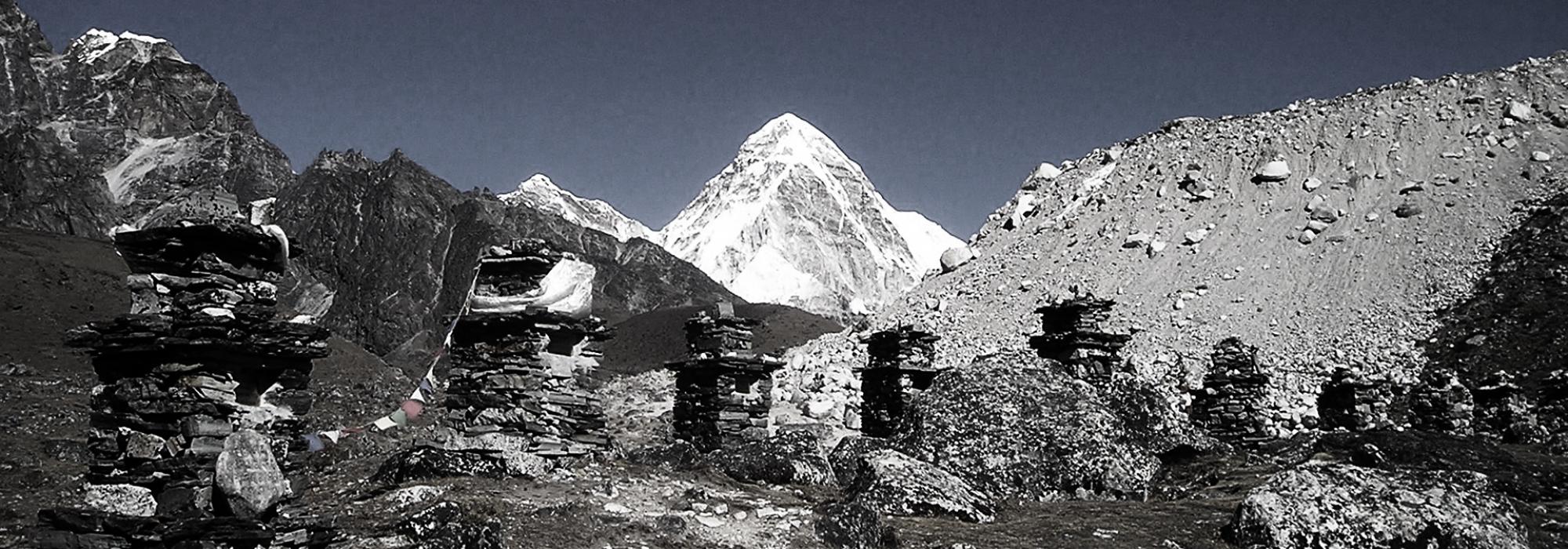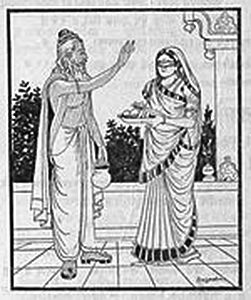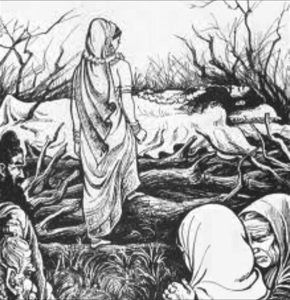Back at Hastināpura, Gāndhārī too was pregnant; even as she was carrying, she heard that Kuntī had given birth to Yudhiṣṭhira. She hadn’t given birth even after two years of pregnancy; the pain was unbearable too. So one day, extremely upset, she squeezed her abdomen and pushed out the foetus. The foetus came out as a ball of flesh. “Is this what Īśvara blessed has me with in the past; is this what Vyāsa promised!” Thinking thus with disgust, she was about to throw the ball of flesh away.
At that moment, Sage Vyāsa appeared there and washed the flesh with cold water. It immediately broke up into a hundred pieces. He asked her to keep the pieces in a hundred different pots. As time elapsed, the pieces turned into babies and grew up. Duryodhana was the first to be born thus.[1] Within a month from his birth, ninety-nine children were born one after the other. Apart from these hundred sons, Gāndhārī had a daughter by name Duśśalā. A son named Yuyutsu was born to a vaiṣya lady, a servant of Gāndhārī.
After Yudhiṣṭhira was born, Pāṇḍu called Kuntī and told her, “This son is born to Dharma and is dhārmic by nature; however, the main quality of a kṣatriya is his power; thus, beget a son who is strong!” Accordingly, she invoked Vāyu and gave birth to Bhīma, a son with great physical strength. Something miraculous happened at Bhīma’s birth. He rolled off from his mother’s lap and fell down on a stony rock; the baby was not harmed, but the rock on which he fell broke into a hundred pieces immediately. Duryodhana was born on the same day as Bhīma.
After Bhīma’s birth, Pāṇḍu thought to himself, “I need to procure an extraordinary son. Who shall I beget the son through? Indra is the lord of the devatas; he has tremendous power and radiance; if I impress him, I can obtain a courageous son!” Thinking so, he observed strict tapas for a year along with Kuntī and pleased Indra. Kuntī thus, gave birth to a powerful and radiant son, Arjuna.[2]
Pāṇḍu wanted one more son and when he expressed his wish to Kuntī, she disagreed. “No āpaddharma prescribes begetting more than three children. Thus, if I get one more, it will look like I am an unfaithful wife and a whore!” Kuntī said. Pāṇḍu remained silent.
In this manner, Kuntī and Gāndhārī gave birth to children. Looking at this, Mādrī spoke to Pāṇḍu in private: “My beloved! I’m not distressed looking at your current condition or that I am inferior to my co-wife; Gāndhārī had a hundred children and that does not bother me either. However, what bothers me the most is that my co-wife has had children and I, who should have had an equal footing, have not given birth to children. Now, if Kuntī makes up her mind, I too can beget children and that will please you too. I cannot broach this topic with my co-wife. Have pity on me and ask her, if you can!” Thus she prayed of her husband. Listening to her words, Pāṇḍu said, “Mādrī! This has been bothering me since long too. I kept quiet as I was not sure how you would look at this issue and thought that you might not like such a proposal. Now, I have understood your heart and I will certainly try. I am sure that Kuntī will execute my wish!” Saying so, he went to Kuntī and put forward the proposal. Kuntī agreed and instructed Mādrī in the mantra. She said “Mādrī, use it only once; you will beget a very good son.” Mādrī thought well and invoked the Aśvinī-devatas (twin deities). Through them she gave birth to charming twins: Nakula and Sahadeva.
When Pāṇḍu tried speaking to Kuntī on Mādrī’s behalf a second time, she said, “O king! This is enough, please stop it! She obtained two children using just one mantra; I am deceived. She might overpower me in the future! I’m now scared of her; thus is the fate of a female birth! It never occurred to me that by invoking the twin deities, I can give birth to two children at once! So please don’t bring up this topic again!”
Pāṇḍu, thus, had five children through different deities. The children grew up amidst the tranquil Himalayan ranges. The ṛṣis who resided there were charmed by the children’s beauty, divine traits, and lion-like courage. These five and Dhṛtarāṣṭra’s hundred children grew up as the new sprouts of the Kuru clan. They blossomed quickly like a lotus in a pond of water.
Some time elapsed in joy and then came spring. There was a bounty of fruits and fragrant flowers all around. The trees bore palāśa, tilaka, mango, bakula, campaka, and several other flowers. Ponds and lakes were filled with lotuses. One day, as Pāṇḍu was spending a relaxed time in the company of Mādrī amidst nature’s beauty, he was overcome with lust. He could not control his desire and as soon as they came to a private spot, he seized Mādrī in a firm grip. Mādrī tried her best to resist his advances. As he was greatly overcome with lust, he disregarded the curse and forcibly had intercourse with her. His wisdom betrayed him as his end came. Pāṇḍu lost his life. Mādrī hugged Pāṇḍu’s lifeless body and screamed. Hearing that, an anxious Kuntī and the children hurried to the spot. “Leave the children behind and come alone!” shouted Mādrī. Accordingly, Kuntī left the children behind and rushed there exclaiming, “Woe upon me!”
Looking at the both of them, who were on the ground, Kuntī said, “I had always protected him; how could you let this happen, knowing all too well about the ṛṣi’s curse? Could you not protect the king, Mādrī? How could you drag him to this uninhabited portion of the forest (and seduce him)? Seeing you all alone – he who was always worried about the curse – how in the world did he become overjoyed! O Mādrī, you are the fortunate one! You are more blessed than I am! You saw the smiling face of our lord, the king!” Saying so, she began weeping. Mādrī replied that she tried her best to stop him and was unsuccessful even after repeated attempts; Pāṇḍu behaved in the way that fate had ordained. Finally, Kuntī said, “I am the senior dharma-patnī (wife); the fruit of dharma is mine; therefore, don’t stop me; I will accompany my husband in his last voyage. Rise!” Mādrī replied, “Let me go; I am the younger wife; my desires are not yet fulfilled; therefore, you being the senior one, give me the permission; the king died after lusting after me; therefore, I shall be alongside him in the world of Yama. Further, you will look after my children far better than I can look after yours!” Saying so, she jumped into the funeral pyre and went along with her husband on the final journey, thus becoming a great satī.
The ṛṣis at Śataśṛṅga performed the antyeṣṭi (last rites) of Pāṇḍu and had a discussion amongst themselves. “This great soul, King Pāṇḍu, abandoned his kingdom and authority and began leading a life of penance among us tapasvis. Having left behind his wife and young children, he has gone to the celestial abode. What shall we do now?” Having meditated upon this matter, they decided that the right thing to do would be to accompany Pāṇḍu’s widowed wife and orphaned children to Hastināpura and hand them over to the care of Bhīṣma and Dhṛtarāṣṭra. Kuntī’s attention was entirely drawn by the children; she never realized the troubles of the journey or the distance they traversed. When they arrived at the main gate of Hastināpura, word spread among the people that numerous siddhas, cāraṇas, and munis have arrived; practically the entire city descended upon the main gate, merely out of curiosity, to catch a glimpse of them all. Bhīṣma, Dhṛtarāṣṭra, Vidura, Satyavatī, Gāndhārī, Ambālikā, and other members of the royal family too came there. Bhīṣma ordered the people gathered there to silence their din and take their seats; he then went ahead to honour the mahaṛṣis in the traditional manner. The senior-most of the mahaṛṣis spoke these words: “A child of the Kuru clan, King Pāṇḍu, relinquished all worldly pleasures and moved from here to the mountains, staying with us and adhering to strict brahmacarya. He had the following five sons: born to Kunti were Yudhiṣṭhira, through the grace of Lord Dharma; Bhīma, through Lord Vāyu; and Arjuna, through Lord Indra; and born to Mādrī were the twins Nakula and Sahadeva through the grace of the Aśvinī devatas. Seventeen days ago, the great king left for the divine abode. Mādrī ascended the funeral pyre with him and gave up her life. Here are the remains of their bodies; take these remains as well as these children under your control, perform all the post-death rituals befitting these great souls!” So saying, he handed them over to the Kauravas. All the siddhas and cāraṇas who had accompanied them on the voyage also left along with the ṛṣis. Within a matter of moments, the scene that resembled a celestial city of the gandharvas melted away into nothingness.
The post-death rituals in memory of Pāṇḍu and Mādrī were performed in a royal manner truly befitting them. Soon after, Vyāsa went to Satyavatī and said, “Mother! The period of peace and comfort has passed; what will follow is an era of difficulties; times are getting worse day by day with a dramatic rise in deception and deceit; dharma will be violated and shall disappear. A ghastly situation will come to be. Therefore, it is better that you renounce everything and begin living in the forest, performing tapas.” She agreed to this suggestion. Her daughters-in-law, Ambikā and Ambālikā, told her that they too shall join her. Thus, the three of them retired to the forest, performed austerities, and in due course left behind their bodies.
The various saṃskāras as ordained in the Vedas were performed on the Pāṇḍavas; having been thus consecrated, the Pāṇḍavas began growing up playing with their cousins, Duryodhana and his hundred brothers. In all games, it was the Pāṇḍavas who would be victorious. Among them, Bhīma excelled everyone in every aspect: in running, in games, in eating, and even in throwing mud. He would catch hold of the Kauravas and punch them; while they were joyfully playing, he would lift them up and hide them somewhere; he would hold their tufts and make them bang their heads together. Although they were a hundred and one, Bhīma would single-handedly torment them all. He’d put his foot in a tricky way, tripping them and making them fall; they would scream, having their knees, foreheads, eyes bruised; while at play in the waters, he would hold the shoulders of ten boys at once and shove their heads into the water, making them palpitate as they craved for a breath of air; when they climbed a tree in search of fruits, he would shake the tree trunk vigorously; the fruits would plop down one by one; together, they too would fall to the ground like the fruits. In wrestling or athletics, try as they might, the Kauravas were no match to Bhīmasena. All these activities and adventures of Bhīma were childish expressions and were not motivated by any malicious designs or hatred towards his cousins. However, it was due to these actions that he was expressly detested by the Kauravas, right from an early age.
As Bhīmasena’s prowess was hailed, Duryodhana’s hatred towards him increased manifold; his malevolence slowly began manifesting; his mind turned towards sin out of deep-rooted aviveka (lack of wisdom) and avarice for riches. “If we can kill this mighty Bhīma somehow, by hook or by crook, then I shall imprison his brothers and rule over this kingdom!” he thought to himself. He was ever-vigilant, waiting for an opportunity to execute his plan. This being the case, one day all the boys went to a place called Pramāṇakoṭi to play water sports. After play, they wore fresh clothes, decorated themselves, and ate heartily. Having played relentlessly until dusk, upon nightfall they slept in the tents that were erected nearby. Bhīma had made everyone run around a great deal and exerted himself too, so he was exhausted; he spotted a cool place and fell asleep as soon as his body hit the ground. A sound sleep engulfed him. Bhīma was thus in deep sleep, motionless as a corpse; Duryodhana bound Bhīma’s unstirring body by means of creepers, heaved his gigantic body on his shoulders, and threw him in a deep river. But the moment Bhīma gained consciousness he broke free from the creeper-bonds and rose to the surface. On another occasion, when Bhīma was similarly asleep, Duryodhana set free several poisonous serpents to bite him. But their teeth could hardly penetrate his skin; the moment he awoke, he fought with the snakes and killed them all.[3] On yet another occasion, Duryodhana had a lethal poison mixed with Bhīma’s meal. But the poison was completely digested instead of harming Bhīma in any manner whatsoever.[4] Therefore, several times Duryodhana tried to kill all the Pāṇḍavas by employing various tactics. Even the Pāṇḍavas realized this. They became extremely vigilant and went about following the sage advice of Vidura in all matters.
This is an English translation of Prof. A R Krishna Shastri’s Kannada classic Vacanabhārata by Arjun Bharadwaj and Hari Ravikumar published in a serialized form. Thanks to Śatāvadhāni Dr. R Ganesh for his thorough review and astute feedback.
Additional segments from the epic and notes by the translators have been added in the footnotes. Apart from reading through the Critical Text of the Mahābhārata, the Kannada translations of Ka Sri Nagaraj, Devashikhamani Alasingacharya, and of Bharata Darshana Publications as well as the English translations of Kisari Mohan Ganguli and Bibek Debroy have been consulted in the preparation of this series.
Footnotes
[1] Several bad omens were observed upon the birth of Duryodhana. Vidura then advised his elder brother to abandon Duryodhana since he would grow up to become evil and destroy the Kuru clan. He says, “For the good of the clan, an (evil) individual must be abandoned; a (rotten) clan must be abandoned for the good of the village; for the sake of the kingdom, a village may be abandoned; and the whole earth may be abandoned for the sake of the ātman (inner Self).” Dhṛtarāṣṭra, however, did not heed to Vidura’s advice out of excessive attachment to his son.
[2] After the birth of each of the Pāṇḍavas, an aśarīravāṇi (invisible voice) was heard. When Yudhiṣṭhira was born, a voice was heard that proclaimed that he would be a great upholder of dharma and rule as a king. When Bhīma was born, an invisible voice pronounced that he would be the strongest among the strong. When Arjuna was born, the voice declared that he would attain great fame and perform unmatched feats.
[3] Translators’ Note: In the Citraśālā Edition we find the story of Bhīma going to the underwater abode of the Nāgas and obtaining the strength of thousands of elephants after drinking a potion that they offer him.
[4] On one occasion Yuyutsu, the son of Dhṛtarāṣṭra from a vaiśya woman, warns the Pāṇḍavas about the poisoned food.



















































